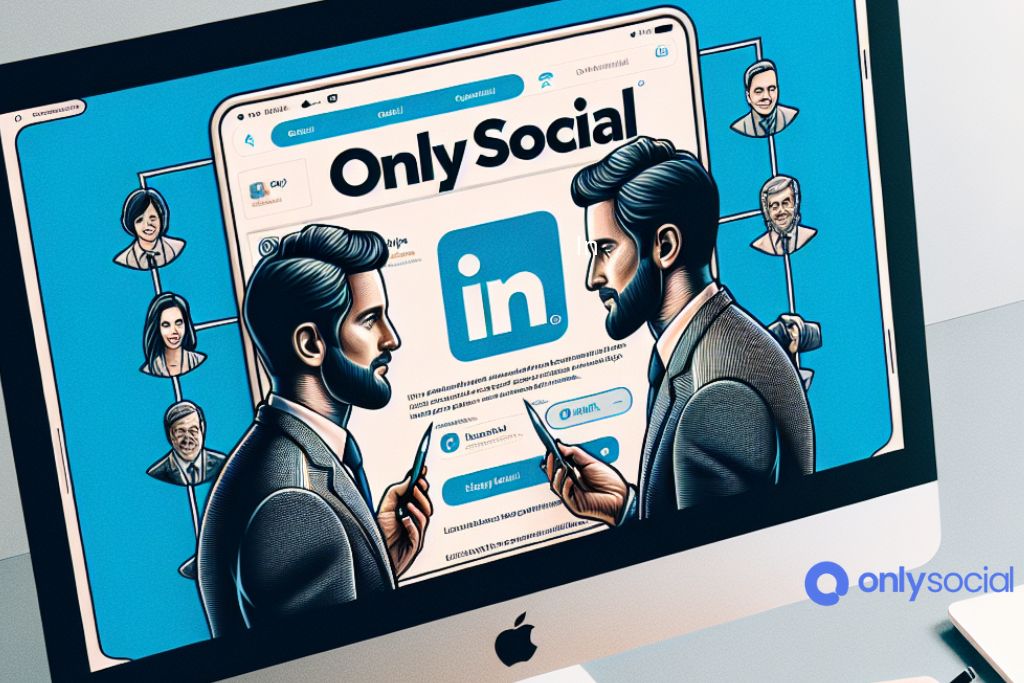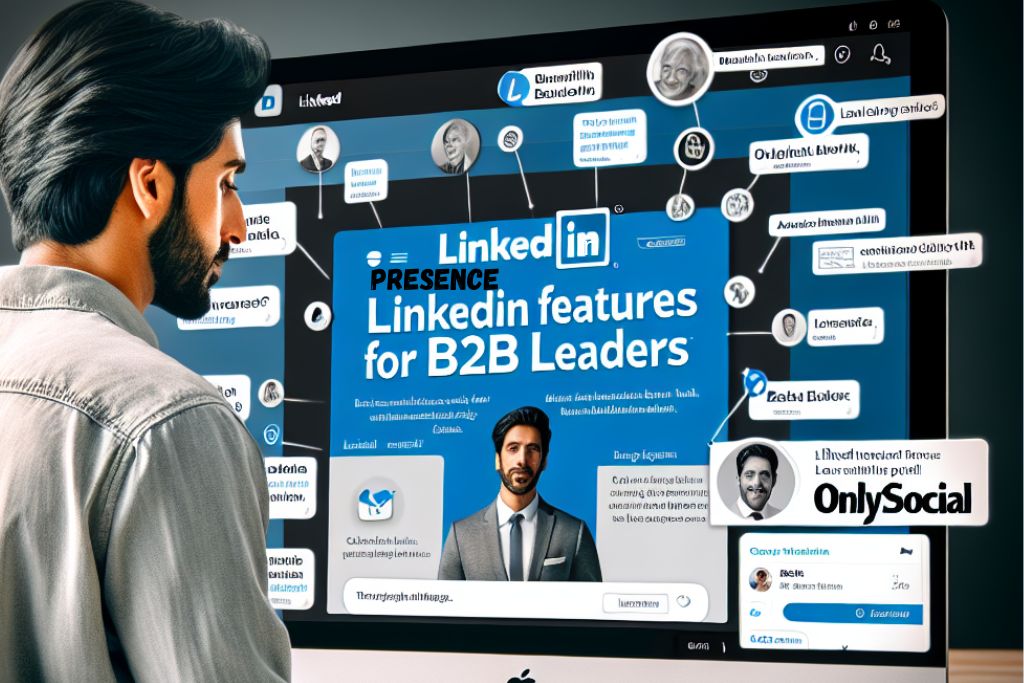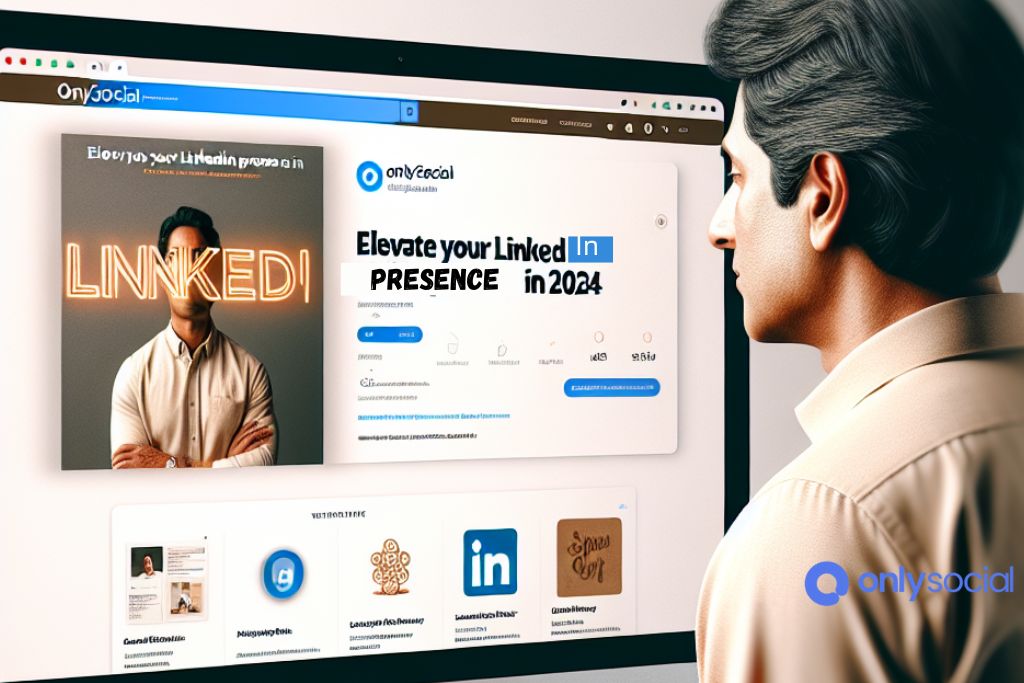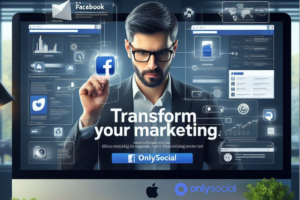In the fast-evolving digital landscape of 2024, LinkedIn remains a quintessential platform for B2B leaders keen on amplifying their professional brand and business connections. However, the sheer volume of content and competition can make standing out a significant challenge. This is where Powerful Strategies come into play, serving as your arsenal in carving a distinctive presence on LinkedIn that resonates with your target audience and fosters meaningful business opportunities.
Utilizing Powerful Strategies on LinkedIn is not merely about optimizing your profile or being active; it’s about strategically positioning yourself as an indispensable resource in your industry. By deploying targeted tactics designed to enhance visibility, engage effectively with your network, and showcase your expertise, you’ll be positioned to lead and influence within your professional community.
Make no mistake, achieving LinkedIn success in 2024 demands more than just consistency – it calls for ingenuity, personal branding excellence, and a profound understanding of what drives engagement in a B2B context. In the forthcoming sections, we’ll unveil ten transformative strategies that will not only elevate your LinkedIn presence but ensure it thrives amidst the digital noise.
Prepare to delve into the nuances of creating a compelling LinkedIn profile that captures attention, crafting content that engages and inspires your audience, and networking techniques that forge valuable connections. These Powerful Strategies are your roadmap to not just navigating LinkedIn’s complex ecosystem but mastering it.
Embrace the journey ahead with a mindset geared towards continuous learning and adaptability. With every connection made, post shared, and insight gained, you’re laying down the bricks of your LinkedIn success story. Let’s embark on this journey to unearth the potential of Powerful Strategies to transform your LinkedIn presence in 2024 and beyond.
Table of Contents
- 1 Understanding the LinkedIn Landscape in 2024
- 2 Crafting a Compelling LinkedIn Profile
- 3 Strategic Networking and Engagement
- 4 Utilizing LinkedIn for Thought Leadership
- 5 Advanced LinkedIn Features for B2B Leaders
- 5.1 Utilize LinkedIn Sales Navigator
- 5.2 Leverage LinkedIn Analytics for B2B Marketing
- 5.3 Enhance Your LinkedIn Company Page
- 5.4 Implement LinkedIn Advertising Strategies
- 5.5 Host and Participate in LinkedIn Live Events
- 5.6 Use LinkedIn Learning to Develop Your Team
- 5.7 Collaborate Through LinkedIn Groups
- 6 Analyzing and Optimizing Your LinkedIn Strategy
- 7 BONUS
- 8 Frequently Asked Questions
Understanding the LinkedIn Landscape in 2024

The digital terrain of LinkedIn is perpetually evolving, shaped by technological advancements and the shifting dynamics of professional networking. As we navigate through 2024, understanding the current LinkedIn landscape is paramount for B2B leaders aiming to deploy Powerful Strategies that resonate well with their objectives. This foundational knowledge serves as the bedrock for crafting a LinkedIn presence that not only stands out but also significantly contributes to your professional and business growth.
The Role of LinkedIn in Today’s B2B Environment
- Central Hub for Professional Networking: LinkedIn continues to be the premier platform for professional networking, offering unparalleled opportunities for B2B leaders to connect, collaborate, and share insights.
- Showcase for Thought Leadership: It represents a powerful channel to demonstrate thought leadership, with content playing a pivotal role in shaping industry conversations.
Recent Changes and Updates on LinkedIn
- Algorithm Updates: Understanding recent tweaks to the LinkedIn algorithm is crucial. Content that fosters meaningful interactions and community engagement is being prioritized.
- New Features: LinkedIn has rolled out a range of new features aimed at enhancing user engagement and providing more dynamic content creation tools. Familiarity with these can enable B2B leaders to craft more engaging and interactive content.
Trends Impacting LinkedIn Strategy in 2024
- Personal Branding as a Necessity: The importance of personal branding on LinkedIn has intensified. In 2024, how you craft your personal brand can significantly impact your visibility and influence on the platform.
- Rise of Video and Interactive Content: Video content, live broadcasts, and interactive posts are witnessing greater engagement rates, signaling a shift towards more visually engaging content formats.
- Increased Emphasis on Authentic Engagement: Genuine interactions, from commenting on posts to participating in discussions, are more important than ever. LinkedIn’s ecosystem values authenticity, rewarding those who engage sincerely.
Leveraging Powerful Strategies for 2024
- Keyword Optimization for Your Profile: This continues to be a fundamental strategy. Ensuring your profile is optimized with relevant keywords can dramatically enhance your visibility.
- Strategic Content Creation: Emphasizing quality over quantity. Your content strategy should focus on delivering valuable insights, fostering engagement, and establishing your voice in the industry.
- Networking with Intent: Purposeful networking, focusing on building relationships that offer mutual value, remains a cornerstone of a successful LinkedIn strategy.
- Utilizing LinkedIn Analytics: Leveraging analytics to refine and adapt your strategy. Understanding what content resonates with your audience and why can provide valuable insights for future planning.
As B2B leaders looking to make a marked impact on LinkedIn in 2024, it’s essential to stay abreast of these trends and features. Implementing Powerful Strategies that align with the current landscape is key to unlocking your potential on the platform. With a deep understanding of LinkedIn’s evolving dynamics, you’re better equipped to navigate its challenges and capitalize on the opportunities it presents.
Crafting a Compelling LinkedIn Profile
In the digital age, your LinkedIn profile acts as your virtual business card, resume, and personal brand all rolled into one. It’s often the first point of contact between you and potential employers, clients, or collaborators. Therefore, employing Powerful Strategies to craft a profile that not only stands out but also effectively communicates your unique professional value proposition is crucial. Here’s how to make your LinkedIn profile compelling and memorable:
Optimize Your Profile for Visibility
- Use a Professional Profile Picture: Choose a clear, professional photo that conveys your professionalism and approachability.
- Craft a Memorable Headline: Your headline should go beyond just your job title, incorporating key skills and specialties that make you stand out.
- Customize Your LinkedIn URL: Personalize your LinkedIn profile URL to improve searchability and make it easier to share.
Showcase Your Professional Narrative
- Articulate Your Story in the Summary: Use the summary section to tell your professional story. Highlight your passion, key achievements, and what sets you apart.
- Highlight Relevant Experience: In the experience section, list current and past roles, emphasizing achievements and responsibilities using specific examples and metrics.
- Incorporate Keywords: Strategically use industry-relevant keywords throughout your profile to enhance discoverability in search results.
Demonstrate Your Expertise and Achievements
- List Key Skills and Endorsements: Choose skills that are most relevant to your profession and seek endorsements from colleagues and industry peers.
- Showcase Your Work with the Featured Section: Utilize the Featured section to display your best work, including articles, videos, project images, or other important documents.
- Add Certifications and Courses: Display any relevant certifications, courses, or degrees that contribute to your professional credibility.
Engage with Your Network Through Recommendations
- Request Recommendations: Politely ask for recommendations from colleagues, clients, or supervisors who can vouch for your work and character.
- Give Recommendations: Offer to write recommendations for your connections. This not only aids their professional branding but encourages reciprocity.
Regularly Update and Refresh Your Profile
- Keep Information Current: Regularly review and update all sections of your profile to reflect your latest achievements and career developments.
- Review and Refresh Keywords: As your career focus shifts, adjust your keywords to ensure your profile continues to appear in relevant searches.
Be Active and Engaged
- Share Relevant Content: Post articles, insights, and updates relevant to your industry to demonstrate your engagement with current trends.
- Interact with Your Network: Like, comment on, and share content from your connections to foster relationships and increase your visibility.
Crafting a compelling LinkedIn profile is an ongoing process that requires attention to detail and strategic effort. By implementing these Powerful Strategies, you can ensure that your profile not only captures attention but also accurately reflects your professional brand and opens doors to new opportunities in your career.
Strategic Networking and Engagement
Networking and engagement on LinkedIn are crucial components of a successful professional strategy. In a space crowded with professionals and thought leaders, standing out requires not just connection but meaningful interaction. Below are Powerful Strategies designed to maximize your networking efforts and engagement levels, ensuring you build valuable professional relationships and establish a strong presence on LinkedIn.
Prioritize Meaningful Connections
- Quality Over Quantity: Focus on connecting with individuals who align with your professional goals or interests. It’s more beneficial to have a smaller network of meaningful connections than a large number of superficial ones.
- Personalize Your Connection Requests: Always add a personal note to your connection requests, mentioning why you want to connect or highlighting any commonalities. This personal touch can significantly increase your acceptance rate.
Engage Proactively and Thoughtfully
- React and Comment: Regularly like, comment on, and share content from your connections. Thoughtful comments that add value to the conversation are especially effective in fostering engagement.
- Post Valuable Content: Share insights, articles, and updates that are valuable to your network. Quality content that sparks interest or discussion can help establish you as a thought leader in your field.
Use LinkedIn Groups Strategically
- Join Relevant Groups: Find and join LinkedIn groups related to your industry or interests. These can be valuable spaces for networking and sharing knowledge.
- Be an Active Participant: Don’t just join groups; participate actively by commenting on discussions and sharing relevant content. Engaging in group activities can expand your network and increase your visibility.
Harness the Power of LinkedIn Features for Networking
- LinkedIn Events: Attend virtual events or webinars relevant to your industry. Hosting your own events can also be a powerful way to connect with others and showcase your expertise.
- LinkedIn Messages: Use LinkedIn Messages to reach out to new connections with a thank-you message or to spark a conversation. Personalized messages can lead to more meaningful interactions.
Implement Networking Goals and Strategies
- Set Clear Objectives: Define what you aim to achieve through your LinkedIn networking activities, whether it’s expanding your network in a specific industry, finding job opportunities, or establishing partnerships.
- Schedule Regular Networking Activities: Dedicate time each week for networking activities, including engaging with posts, sending personalized connection requests, and participating in group discussions.
Leverage Recommendations and Endorsements
- Seek Recommendations: Request recommendations from colleagues, clients, or employers who can speak to your abilities and contributions. Recommendations add credibility and depth to your profile.
- Endorse Skills: Endorse the skills of your connections and, where appropriate, request endorsements in return. Skill endorsements add to your professional credibility and visibility.
Stay Consistent and Authentic
- Consistent Engagement: Maintain a regular presence on LinkedIn, engaging with connections and content even when you’re not actively job searching or seeking new opportunities.
- Authenticity is Key: Ensure your interactions on LinkedIn reflect your authentic professional self. Genuine engagement is more likely to lead to valuable connections and opportunities.
Implementing these Powerful Strategies requires a strategic approach to networking and engagement on LinkedIn. By focusing on meaningful connections, thoughtful engagement, leveraging LinkedIn’s features, and maintaining consistency and authenticity, you can significantly enhance your professional networking efficacy and visibility on the platform.kedIn profile is an ongoing process that requires attention to detail and strategic effort. By implementing these Powerful Strategies, you can ensure that your profile not only captures attention but also accurately reflects your professional brand and opens doors to new opportunities in your career.
Utilizing LinkedIn for Thought Leadership

Establishing yourself as a thought leader on LinkedIn requires more than just sharing content; it demands a strategic approach to engaging with your network and the broader community. Powerful Strategies for thought leadership on LinkedIn involve a combination of creating insightful content, leveraging LinkedIn’s tools, and actively participating in the professional community. Here’s how to harness the full potential of LinkedIn for thought leadership:
Create Insightful and Original Content
- Publish Articles: Use LinkedIn’s publishing platform to write articles that reflect your expertise and insights into your industry. Topics can range from trend analyses to advice for professionals in your field.
- Share Innovative Ideas: Post about innovative ideas or approaches in your industry. Sharing forward-thinking content can position you as a leader in your field.
Engage with Industry Trends and News
- Comment on Trending Topics: Share your thoughts on industry news and trends by posting comments or writing posts that offer a unique perspective.
- Curate Content: Share relevant articles, videos, and resources from credible sources, along with your commentary or takeaways.
Foster Community and Engagement
- Initiate Discussions: Post questions or prompts that encourage your network to engage in meaningful discussions. Engaging your audience in dialogue can enhance your reputation as a thought leader.
- Respond to Comments: Actively respond to comments on your posts to foster a community and show that you value the conversation.
Leverage Multimedia and Interactive Features
- Incorporate Videos: Share video content, such as vlogs, interviews, or panel discussions, to provide a richer, more engaging way to communicate your insights.
- Use LinkedIn Live: Host live sessions to talk about industry topics, host Q&A sessions, or share live updates from industry events.
Collaborate with Other Thought Leaders
- Co-create Content: Collaborate with other professionals or thought leaders in your industry to co-author articles or co-host webinars, which can broaden your reach and add depth to your content.
- Engage with Influencers: Regularly engage with content posted by influencers in your industry. Commenting thoughtfully on their posts can increase your visibility and connect you with new audiences.
Educate Your Audience
- Host Webinars and Workshops: Use LinkedIn to promote and host webinars or workshops on topics where you can share your expertise and interact with participants live.
- Share Case Studies and Success Stories: Post case studies or success stories that highlight your achievements or lessons learned, which can illustrate the practical application of your ideas.
Monitor and Analyze Your Impact
- Use LinkedIn Analytics: Regularly review your LinkedIn analytics to understand which types of content resonate most with your audience and why.
- Adjust Your Strategy: Be prepared to adjust your content and engagement strategy based on feedback and performance metrics to continuously improve your impact as a thought leader.
Implementing these Powerful Strategies for thought leadership on LinkedIn allows you to not only share your expertise but also build a community around your insights and ideas. Thought leadership is about more than just knowledge—it’s about inspiring others, prompting discussion, and leading by example in your industry. By actively engaging with your audience, staying atop of industry trends, and leveraging the unique features of LinkedIn, you can establish a strong thought leadership presence that drives conversations and fosters learning and development within your professional circle.
Advanced LinkedIn Features for B2B Leaders

For B2B leaders, LinkedIn is not just a networking site; it’s a powerful platform for driving business growth, building brand awareness, and establishing thought leadership.aging LinkedIn’s advanced features with Powerful Strategies can significantly enhance your B2B marketing, sales, and engagement efforts. Here’s how you can make the most of these features:
Utilize LinkedIn Sales Navigator
- Targeted Lead Searches: Use Sales Navigator’s advanced search capabilities to find and connect with decision-makers in your target industries.
- Lead Recommendations: Take advantage of the platform’s lead recommendation feature to discover potential clients or partners.
- InMail Messages: Reach out to prospects directly with personalized InMail messages, even if you’re not connected.
Leverage LinkedIn Analytics for B2B Marketing
- Content Analytics: Use LinkedIn Page analytics to understand what content resonates with your audience. This can help tailor your content strategy to engage more effectively with your target market.
- Follower Analytics: Analyze your follower data to gain insights into your audience demographics. Tailoring your messaging to your audience’s specific needs and interests can increase engagement.
Enhance Your LinkedIn Company Page
- Showcase Pages: Create Showcase Pages for different segments of your business to target specific audiences with tailored content.
- Career Pages: If attracting top talent is a priority, use Career Pages to highlight your company culture and advertised job opportunities.
Implement LinkedIn Advertising Strategies
- Sponsored Content: Use Sponsored Content to promote your company’s updates to a targeted audience beyond your existing followers.
- Text Ads and Sponsored InMail: Employ LinkedIn Text Ads and Sponsored InMail for direct targeting. These can be highly effective for lead generation and event promotion.
Host and Participate in LinkedIn Live Events
- LinkedIn Live: Host live events to engage in real-time with your audience. Live Q&A sessions, product demos, or industry discussions can be very engaging and build authenticity.
- Virtual Conferences: Participate in or host virtual conferences on LinkedIn to establish your brand’s presence and authority in your industry.
Use LinkedIn Learning to Develop Your Team
- Skill Development: Encourage your team to use LinkedIn Learning for professional development. Keeping your team’s skills sharp can boost your company’s efficiency and innovation.
- Share Insights: Share relevant courses or insights from LinkedIn Learning within your organization to foster a culture of continuous learning and improvement.
Collaborate Through LinkedIn Groups
- Industry-Specific Groups: Join or create LinkedIn Groups related to your industry or business interests. These can be valuable for sharing insights, asking questions, and building a community around your brand.
- Engage Actively: Regularly contribute to discussions in groups, offering your expertise and insight. This can increase your visibility and position your brand as a thought leader in your space.
Implementing these Powerful Strategies allows B2B leaders to fully capitalize on the advanced features LinkedIn offers. Whether it’s for lead generation, market research, brand promotion, or team development, LinkedIn provides a wealth of tools designed to support and enhance your business activities. By thoughtfully integrating these features into your LinkedIn strategy, you can drive meaningful engagement, foster lasting connections, and ultimately accelerate your business growth on this dynamic B2B platform.
Analyzing and Optimizing Your LinkedIn Strategy
For professionals and businesses alike, a well-defined LinkedIn strategy is crucial for success. However, without constant analysis and optimization, even the most comprehensive strategy can fall short of its objectives. Incorporating Powerful Strategies to analyze and optimize your LinkedIn efforts ensures continuous improvement and maximized outcomes. Here’s how you can keep your LinkedIn strategy dynamic and effective:
Set Clear Objectives and KPIs
- Define Your Goals: Start by clearly defining what you want to achieve with your LinkedIn strategy, be it brand awareness, lead generation, or thought leadership.
- Identify Key Performance Indicators (KPIs): Establish specific, measurable KPIs that reflect your goals. This could include metrics like connection requests accepted, engagement rates, or InMail response rates.
Regularly Review LinkedIn Analytics
- Monitor Engagement Metrics: Use LinkedIn’s built-in analytics tools to track how users are engaging with your content, including likes, comments, shares, and impressions.
- Analyze Visitor and Follower Demographics: Understand who your audience is by analyzing data on visitor and follower demographics, including job functions, industries, and geographical locations.
| Metrics to Monitor | Description | Why It Matters |
|---|---|---|
| Engagement Rate | The percentage of interactions per post relative to your number of followers or reach. | Helps gauge the relevance and appeal of your content. |
| Profile Views | The number of times your LinkedIn profile has been viewed. | Indicates interest in you or your business and can reflect the effectiveness of your engagement strategies. |
| Search Appearances | How often have you appear in LinkedIn searches? | Reflects the visibility and discoverability of your profile. |
| Article and Post-Performance | Views, likes, comments, and shares for each article or post. | Provides insights into what content resonates with your audience. |
Experiment with Content and Timing
- Test Different Content Formats: Experiment with various types of content (articles, posts, videos) to see what generates the most engagement among your target audience.
- Vary Posting Times: Experiment with posting at different times of the day and week to identify when your audience is most active.
Engage with Your Network
- Respond to Feedback: Pay close attention to comments and messages. Engaging with your audience can provide valuable insights into what they value or would like to see more of.
- Analyze Networking Efforts: Keep track of new connections and interactions to see if your networking efforts are bringing you closer to your strategic goals.
Utilize A/B Testing for Optimization
- Implement A/B Testing: Regularly conduct A/B tests on your profile elements, such as your headline, summary, or even different styles of posts, to determine what versions perform the best.
- Track and Analyze Results: Use the data from your A/B tests to make informed decisions about your LinkedIn strategy. Document these insights to refine your approach over time.
Keep Up with LinkedIn Updates
- Stay Informed: LinkedIn continually updates its platform and introduces new features. Staying informed about these changes can help you adapt your strategy to leverage new tools and functionalities.
Schedule Regular Strategy Reviews
- Quarterly Reviews: Set aside time each quarter to review your LinkedIn strategy against your set objectives and KPIs. Assess what’s working and what isn’t.
- Adjust Strategy Accordingly: Based on your review, make necessary adjustments to your strategy. This could involve focusing on different types of content, changing your posting schedule, or even redefining your objectives.
By implementing these Powerful Strategies, you can ensure that your LinkedIn strategy is not only aligned with your business goals but also adaptable to the changing digital landscape. Regular analysis and optimization are key to staying ahead in the dynamic world of LinkedIn, allowing you to continuously refine your approach for maximum impact.
BONUS
Elevating your LinkedIn presence as a B2B leader in 2024 requires meticulous planning and consistent engagement. OnlySocial’s Post Planning and Scheduling function is designed to streamline this process. With the capability to manage unlimited social profiles and execute unlimited posting, your content will consistently engage your target audience at optimal times across all networks. This tool not only saves time but also enhances your social media strategy’s effectiveness. Leverage OnlySocial to ensure your LinkedIn content works as hard as you do. Sign up now for a commitment-free 7-day trial today.
Frequently Asked Questions
How can I improve my visibility on LinkedIn?
To improve your visibility on LinkedIn, consistently post valuable content, engage with your network by liking, commenting, and sharing, optimize your profile with relevant keywords, and actively participate in groups within your industry.
What are the best practices for LinkedIn content?
The best practices for LinkedIn content include sharing insights and trends relevant to your industry, using a mix of post types (articles, photos, videos), tagging relevant individuals or entities, using hashtags wisely, and encouraging engagement by ending posts with a question or call-to-action.
How often should I post on LinkedIn to engage my audience?
Ideally, posting 1-2 times per day is a good strategy for engaging your audience without oversaturating their feed. The key is consistency and providing value, rather than just frequency.
Can LinkedIn Sales Navigator really help in generating leads?
Yes, LinkedIn Sales Navigator can significantly help in generating leads by providing enhanced search capabilities, personalized lead recommendations, and the ability to send InMail messages to prospects, even if you’re not connected.
Is it worth investing in LinkedIn Premium or Sales Navigator for B2B marketing?
For many B2B marketers, investing in LinkedIn Premium or Sales Navigator is beneficial due to the advanced networking, insights, and targeting tools they offer, which can enhance lead generation and sales strategies.
How important are LinkedIn Groups for my business?
LinkedIn Groups can be very important for your business as they provide a platform for engaging with peers, sharing content, establishing thought leadership, and networking with potential clients or partners in your industry.
What metrics should I focus on to measure my LinkedIn strategy’s success?
Focus on metrics such as profile views, post engagement (likes, comments, shares), follower growth, reach, website traffic from LinkedIn, and InMail response rates to measure the success of your LinkedIn strategy.
How can I optimize my LinkedIn profile for search?
Optimize your LinkedIn profile for search by including relevant keywords in your headline, summary, and experience sections, completing all profile fields, and obtaining endorsements for the skills that are most essential to your field.
What are the most effective ways to use LinkedIn for job searching?
The most effective ways to use LinkedIn for job searching include optimizing your profile with relevant keywords, making connections in your industry, asking for recommendations, actively searching and applying for jobs through LinkedIn jobs, and engaging with potential employers’ content.
What’s the difference between LinkedIn Pages and LinkedIn Profiles?
LinkedIn Profiles are for individuals, allowing them to showcase their professional experience, skills, and interests. LinkedIn Pages are for organizations, companies, and brands to share updates, insights, and job postings, and engage with their audience and employees.




